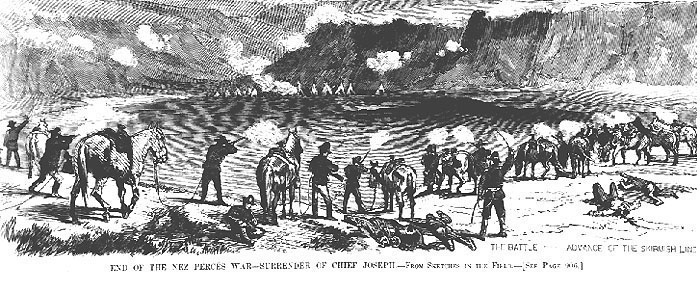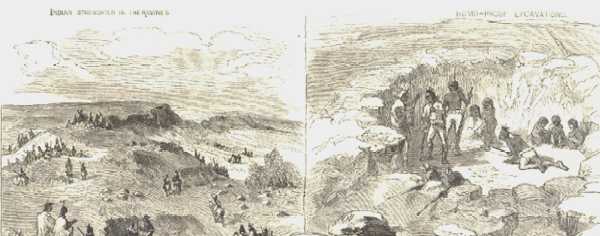

End of the Nez Perce War - Bear Paw Battle Field, November 17, 1877
Issue

End of the Nez Perce War, The Surrender Of Joseph
"On September 30 Colonel MILES made a sudden attack on the enemy, whose camp was
situated on a bench or flat in the creek bottom. The Indians occupied the crests of the
surrounding hills, and repulsed the charge made on the right by three companies of the
Seventh Cavalry. A line of dead horses marked the course of the charge; and the loss,
either killed or wounded, of every commissioned officer but one, of every first sergeant,
and many non-commissioned officers, told how coolly it was received. . . . The men
dismounted, tied their lariats round the left arm, and led their horses. Whenever a
soldier stopped a moment, his horse would quietly graze—a strange sight on a
battlefield! The Indians were finally forced to abandon their camp and to occupy the
adjacent ravines, which were well protected from the fire, and which they honey-combed
with pits and bomb-proofs. The Nez PercÚs occupied and held the crests on the north
immediately overlooking their own position. Things remained in this condition until the
surrender.
The same bugler who sounded "To the charge!" on the 30th, trumpeting the death-call of so many brave fellows, now blew the calming and welcome call of "Cease firing." The effect on the Indian camp was almost instantaneous. Where, a moment before, not a head was to be seen nor any sign of life, the ravines now warmed with people, and little children capered in the sunshine and laughed in the face of death. They seemed to be the swarthy children of the earth, born in a moment, cast forth as if by magic. General HOWARD arrived on October 4, bringing with him his two herders, "CAPTAIN JOHN" and "GEORGE," friendly Nez PercÚs. Both of these men had daughters in the hostile camp. CAPTAIN JOHN is a friend of long standing to the whites. He fought by the side of STEPTOE, and helped him during his retreat. One parley with JOSEPH, held on the 2d of October, had been unsuccessful; but JOHN, with tears in his eyes, announced the surrender as concluded by JOSEPH’S final reply. Our artist was the only person present who committed the proceedings to writing, and took the reply as it fell from the lips of the speaker.
JOSEPH’S little girl was lost in the hills during the first day’s fight, his brother was killed, his relatives dead or fugitives; he upheld now only a lost cause. His answer was: "Tell General HOWARD I know his heart. What he told me before, I have it in my heart. I am tired of fighting. Our chiefs are killed: LOOKING-GLASS is dead, TA-HOOL-HOOL-SHUTE is dead. The old men are all dead. It is the young men who say ‘Yes’ or ‘No.’ He who led on the young men is dead. It is cold, and we have no blankets; the little children are freezing to death. My people, some of them, have run away to the hills, and have no blankets, no food. No one knows where they are—perhaps freezing to death. I want to have time to look for my children, and see how many of them I can find. Maybe I shall find them among the dead. Hear me my chiefs! I am tired; my heart is sick and sad. From where the sun now stands I will fight no more forever."
Attended by five warriors, he on horseback, they on foot, JOSEPH rode slowly up the hill, where General HOWARD and Colonel MILES stood to receive him. His hands were crossed on the pommel of the saddle, and his head was bowed upon his breast. After receiving him, General HOWARD and Colonel MILES mounted their horses, and accompanied the chief to MILE’S tent. After the surrender, the Indian stronghold was filled with eager and curious visitors, who for days had invested the place, yet unable to get even a glimpse of its arrangement. The ravines were so crooked as to prevent enfilade fire, and so protected by hills as to be safe from our sharpshooters. The Indian rifle-pit from which the sketch was taken is the only point that affords any thing like a comprehensive view of the plan,and even from this stand-point much is unseen. JOSEPH has a gentle face, somewhat feminine in its beauty, but intensely strong and full of character. A photograph could not do him justice. A bullet scratch has left a slight scar on his forehead. In each shirt sleeve and in the body of the shirt are bullet holes, and there was also a bullet hole in one of his leggings, a bullet scratch on his wrist, and one across the small of his back. Colonel MILES begged his shirt as a curiosity, so full was it of visible evidence that JOSEPH had been where lead was flying. . . . (pp. 906 )